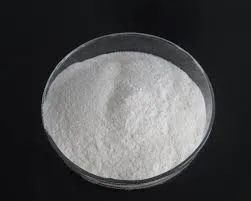
სექ . 25, 2024 06:11 Back to list
Exploring the Applications and Benefits of Hydroxypropyl Methyl Cellulose in Various Industries
Hydroxypropyl Methyl Cellulose (HPMC) is a versatile and widely used cellulose derivative that finds applications across various industries. This water-soluble polymer is synthesized from natural cellulose, a fundamental component of plant cell walls, making it a biodegradable and environmentally friendly option. HPMC is primarily known for its thickening, emulsifying, and film-forming properties, which are crucial in many formulations, particularly in pharmaceuticals, food, cosmetics, and construction.
In the pharmaceutical industry, HPMC serves multiple critical functions. It is commonly used as an excipient in tablet formulations, providing controlled release of active pharmaceutical ingredients (APIs). By adjusting the viscosity and solubility of the formulation, HPMC ensures that the API is released at a consistent rate, enhancing its bioavailability and therapeutic effectiveness. Additionally, HPMC is employed in the production of capsules, where it acts as a vegetarian alternative to gelatin. This is especially beneficial for vegan and vegetarian consumers seeking dietary supplements without animal-derived ingredients.
.
In cosmetics and personal care products, HPMC is valued for its emulsifying and stabilizing characteristics. It is commonly found in lotions, creams, and gels, where it helps to achieve a smooth texture and improve product spreadability. Additionally, HPMC’s film-forming ability allows for the creation of breathable films on the skin, which can help protect against irritants while maintaining moisture balance.
hpmc hydroxypropyl methyl cellulose

The construction industry has also adopted HPMC for its water-retaining and bonding properties. It is a key ingredient in dry mix mortars, tile adhesives, and wall putties. By enhancing the workability and adhesion of these materials, HPMC ensures better performance and durability, which is critical for construction projects.
Furthermore, HPMC's low toxicity and biocompatibility make it an attractive option for various applications. Its adaptability allows for modifications to tailor its properties for specific uses, resulting in a range of HPMC grades available on the market. Manufacturers can select the appropriate grade based on factors such as viscosity, solubility, and molecular weight, ensuring optimal performance in their formulations.
In summary, Hydroxypropyl Methyl Cellulose is a multifunctional polymer that plays a crucial role in diverse industries. Its properties facilitate improved formulations in pharmaceuticals, enhance product quality in food and cosmetics, and contribute to the performance of construction materials. As the demand for sustainable and effective materials continues to grow, HPMC stands out as a reliable and eco-friendly choice in numerous applications, reflective of the ongoing innovation within this field.
-
Versatile Hpmc Uses in Different Industries
NewsJun.19,2025
-
Redispersible Powder's Role in Enhancing Durability of Construction Products
NewsJun.19,2025
-
Hydroxyethyl Cellulose Applications Driving Green Industrial Processes
NewsJun.19,2025
-
Exploring Different Redispersible Polymer Powder
NewsJun.19,2025
-
Choosing the Right Mortar Bonding Agent
NewsJun.19,2025
-
Applications and Significance of China Hpmc in Modern Industries
NewsJun.19,2025







